Watch Chain Plant
I generally don’t have a great deal of luck growing succulents. I suspect I generally don’t find that middle ground of minimal watering and bright sunlight without cooking them to death, overwatering or letting them starve for water. But, my watch chain plant seems to love the window it’s in and my infrequent watering.
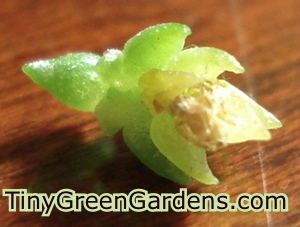 From what I’ve read, it rarely blooms indoors. But, this South African native is currently blooming for me. It may have bloomed before and I just missed it; the flowers are that small and hide within the cup of leaves at the tip of the branches.
From what I’ve read, it rarely blooms indoors. But, this South African native is currently blooming for me. It may have bloomed before and I just missed it; the flowers are that small and hide within the cup of leaves at the tip of the branches.
The blooms are itty bitty white flowers. They don’t look like much more than white tufts – not anything like a daisy, rose or other recognizable flower.
I’ve only spotted three and they are hard to photograph. I finally broke one off to get this photo. It’s still not all that great but it should give you an idea of what watch chain flowers look like.
My Fairy Garden Watch Chain Plant
The window my crussula lives in gets morning sun and bright light most of the rest of the day. I got lucky in that I placed it in the perfect place long before I actually took the time to research this fairy garden plant. My watch chain plant has been growing up the window and seems to do well without support other than the window. It might be reaching for sunlight but it has lived in the same place for around 5-8 years and seems to be doing OK. It definitely needs some TLC though as the surface of the soil is covered with a tangle of dried up stems and pieces.
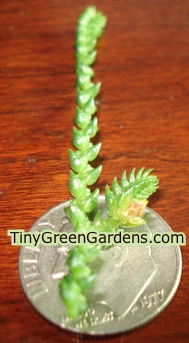 I think it makes a great fairy garden plant. It doesn’t seem to mind being watered only now and again. It looks a bit like moss crossed with undersea coral and has such and interesting shape – the leafed stems are generally square in shape but the triangular-shaped leaves sorta stick out of the side of the stem like on open zipper’s teeth.
I think it makes a great fairy garden plant. It doesn’t seem to mind being watered only now and again. It looks a bit like moss crossed with undersea coral and has such and interesting shape – the leafed stems are generally square in shape but the triangular-shaped leaves sorta stick out of the side of the stem like on open zipper’s teeth.
Newer growth, on mine, has leaves more tightly spaced together. A number of the photos of this succulent that I’ve seen online show the leaves much closer together the entire length of each branch or stem. I wonder if I simply have a different species or that is a sign that I’m not watering it enough. There’s another little flower on this branch. Sorry, I just can’t capture it better than that – it is hard to really see in real life too.
Crassula Muscosa
There are around 200 species within the Crassula genus, including jade. Some can grow as tall as 6 feet; personally I prefer the much smaller varieties. I have no idea which one I have. The varieties are:
- Crassula muscosa var. accuminata
- Crassula muscosa var. muscosa
- Crassula muscosa var. rastafarii
- Crassula muscosa var. sinuata
- Crassula muscosa var. variegata
The name of these plants comes from the Latin word mucosa which generally means “mossy.” Personally, I think it looks more like coral than moss but either way, it is more delicate and ornamental than some other succulents – mine lives with a small jade plant and they complement each other quite nicely.
Watch chain plant or crassula muscosa plants were originally found in South Africa and Namibia. As you would expect from their origins they are only able to survive outside in USDA zones 9 through 12. And, folks living in those areas report that sometimes they have to protect them from overnight cold spells. They tend to get very unhappy if the temperature gets too close to freezing. When in cooler temperatures, it also prefers less water and should not be fertilized.
In captivity, crassula muscosa tends to stay green. In the wild, it can develop bronze tips.
Where crassula muscosa grows naturally, it is considered invasive. While it does not throw seeds or send out runners like most invasive plants, it is said that virtually any broken piece that hits soil grows to produce a new plant. (I’ll try it out and let you know.) The experts list this succulent as low-growing with a maximum height of 15-20 cm or about 6 to 9 inches.
Common names for these succulents are watch chain, rattail crassula, clubmoss crassula, zipper plant, lizard’s tail and princess pine.
Watch chain plants prefer well-draining soil. I can’t remember for sure but I think I planted mine in succulent soil and then added a thin layer of sand – the sand was for decorative purposes moreso than to meet the plant’s needs.
Buy Watch Chain Plant for Fairy Gardens
I purchased my watch chain plant locally a number of years ago but there’s at least 3 different vendors selling live watch chain plants on Amazon.
I have not purchased from any of them; so please let me know how it goes if you do. As these are live plants, they may go out of stock from time to time. If any of the three photos below do now have a displayed price, you might be better off trying one of the others.
Understand What You’re Buying
Looking over reviews of the various plant vendors on Amazon, a lot of the negative reviews for live plants are not entirely fair. When folks didn’t receive their watch chain plant (or whatever other plant they purchased) in a pot, they left negative reviews. Many growers and nurseries will often send plants through the mail “bare root.” While it does cut down on the weight of the box, also consider that it eliminates having a pot.
Ever have a potted plant fall on the floor? We have. And, most of the time the poor plant gets half crushed. Now think about what would happen when a plant travels through the mail and gets tossed and tumbled around in a box in a pot.
If the product description does not mention a pot or has other pricing options that include pots, be prepared to receive a bare root pot by having the proper soil and pot ready beforehand.
UPDATE: 2024
Be Careful Pruning & Moving Watch Chain Plants
Keep in mind, I’m a hobbyist here and no expert. My plant had pretty much taken over my window. I was amazed at how well it managed to hang onto the window glass with no visible support. Oddly enough, the central area of the plant, by the dirt, looked a mess. Lots of what looked like debris and little dead branches. I thought, as the good plant momma I like to be, it should be cleaned up and pruned a bit. Alas, a few tugs on what appeared to be dead branches and the entire plant fell off the window. Dumb on me for not securing it before touching one little leaf. Apparently, watch chain plants are similar to clematis in that their central branches may appear brown and dead but they are most certainly not. Read my lips, hear my despair, be very careful trying to prune or otherwise move a watch chain plant if it is happy where it is.
I have two small tendrils, hanging on by a thread left. The rest of the plant died on me. I tried everything I could think of to save it. I hung it on the window. I repotted some of the broken pieces. Nothing seemed to work. Really frustrating considering how many little pieces that had fallen off and landed on the windowsill had shot out roots.
So, be forewarned, if you have a happy watch chain plant – don’t disturb it. Or, at least firmly secure everywhere it’s spread before you touch it. I don’t know if the collapse shocked it too much or the collapse disturbed too much of the root system; either way – my beautiful window-loving watch chain plant is gone.






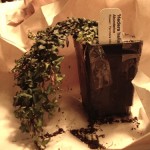


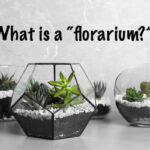


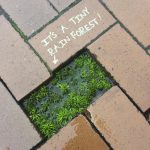
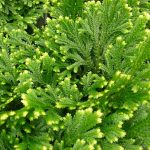

thank you
You are most welcome!
Many thanks for a great article! I can grow jade. I might have to give this a go too. Everything else I’ve tried usually just withers and dies on me.
Great and useful post. Thanks for sharing.
I wanted to know why my main watch chain crassula (and it is true: wherever a broken piece of plant lands, if it’s just on a moist towelette, the thing will sprout. I’ve gotten many offshoots growing in plants that are 10″ away from the nearest watch chain. Fine by me!) tends to dry and die, in the middle of the plant. That question led me here, to a place where there is no answer for that particular question. Huh.
Hi Samantha,
Thank you for your visit. I’m just a fellow amateur blogging about my adventures in tiny green gardening. I wish I did know why watch chain does that. I would guess it wants a bit more sun, more/less water or something like that. Mine’s been somewhat happy for years in a window that gets full morning sun and is relatively bright the rest of the day. But, it does look a bit ragged at times.
Sorry that I couldn’t offer the answer you were looking for.